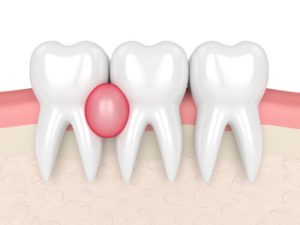If you’ve landed on this article, you might be in a dental pickle. Dental abscesses, especially tooth abscesses, are no small matter. A tooth abscess is a severe dental condition that manifests as a pocket of pus resulting from bacterial infection.
Have you ever heard of someone brushing off a minor toothache only to face a full-blown dental emergency? That’s the devious nature of these abscesses. Knowing about tooth abscess drainage could be the difference between a quick recovery and severe complications.
These painful infections can arise from various causes, such as tooth decay or trauma, demanding prompt attention. This comprehensive guide will delve into tooth abscess drainage and offer insights into its diagnosis, treatment, and prevention.
What is a Tooth Abscess?
A tooth abscess is not just an infected tooth but a sign of a significant imbalance in the oral environment. This condition arises as a pocket of pus that forms within the tooth due to a bacterial invasion. It’s the body’s defence mechanism, attempting to quarantine the harmful bacteria. But, paradoxically, this defence tactic often leads to severe pain and discomfort.
Diving into the Types of Tooth Abscesses
Tooth abscesses aren’t a one-size-fits-all ailment. Depending on the location and cause, they’re classified into three primary categories:
- Periapical Abscess: This type sits at the tip of the tooth’s root. Often stemming from dental caries that penetrate the tooth’s protective layers, reaching the pulp, it’s a sign that the infection has hit the tooth’s heart.
- Periodontal Abscess: Located next to a tooth root within the gums, this abscess is often an aftermath of infections spreading from the tooth root to the surrounding tissues. Gum diseases can also be the culprits here.
- Gingival Abscess: Exclusively found in the gum tissue, this type doesn’t affect the tooth or the surrounding ligament. External traumas, like an accidental jab from a toothpick, often lead to this condition.
Identifying the Causes
While structural damages like severe tooth decay, dental caries, or even a cracked tooth can be evident causes, there are subtler underlying factors to consider. A weakened immune system, for instance, makes one a more likely candidate for these infections. Failed dental procedures, like a root canal that didn’t go as planned, can also be a potential trigger.
Recognising the Symptoms
How does one discern a mere toothache from a burgeoning abscess? The nature of pain is a significant indicator. If it’s persistent, throbbing, and seems to send shoots of discomfort to the ear or neck, it’s a red flag. But pain isn’t the sole messenger. Other symptoms include swollen gums, facial swelling, persistent bad breath, and a notably unpleasant taste in the mouth. Sensitivity to hot or cold stimuli can be another early warning sign to heed.
Why Does an Abscess Need Draining?
While draining might seem daunting to many, it’s necessary to restore oral balance and protect overall health.
The Role of Pus in Our Body
First and foremost, it’s crucial to understand the role of pus in our body. Pus, while often viewed with disdain, is a combination of dead tissue, bacteria, and white blood cells. It forms as the body’s response to bacterial infection to combat and contain the invading microbes. In the case of a tooth abscess, this pus pocket becomes a central character, signifying that the body is actively fighting an infection.
Understanding the Pressure Build-up
An essential reason for draining an abscess, particularly a dental abscess, is the accumulation of pus and the consequent pressure it exerts on surrounding tissues. This pressure is not merely a source of pain; it also impedes blood flow, potentially delaying healing. What starts as a dull ache can soon escalate to an unbearable throbbing pain, radiating to other parts of the face and even the neck. This pressure must be alleviated to relieve pain and facilitate a conducive environment for healing.
Preventing the Spread of Infection
Allowing a tooth abscess to remain untreated risks the infection spreading. From the initial site, the bacteria can reach adjacent teeth gums and penetrate deeper, affecting the jawbone. More alarmingly, if unchecked, this infection can enter the bloodstream, leading to life—threatening sepsis. Draining the abscess is a direct approach to curbing this bacterial spread, acting as a containment strategy.
Safeguarding Overall Health
Beyond the immediate oral cavity, untreated dental abscesses can compromise one’s general health. An abscess poses a greater threat to individuals with a weakened immune system, making them more susceptible to complications. There’s also a correlation between untreated dental abscesses and conditions like heart disease and diabetes. Thus, drainage isn’t just about addressing a dental concern but holistic health preservation.
The Procedure: Step-by-step
Tooth abscess drainage, while seemingly intricate, is a standard procedure that dentists are well-equipped to handle. Every step, from diagnosis to closure, is geared towards patient comfort, optimal healing, and long-term oral health.
Step 1: Diagnosis – Setting the Right Course

Step 2: Local Anaesthesia – Paving the Way for a Comfortable Experience
Pain is the most daunting aspect of any dental procedure for many patients. A local anaesthetic is administered to ensure the drainage process is as comfortable as possible. A slight pinch might be felt as the needle goes in, but the area around the affected tooth becomes numbed within moments. This ensures the patient feels no pain throughout the drainage process, transforming a potentially distressing experience into a bearable one.
Step 3: Incision and Drainage – The Heart of the Procedure
With the area numb, the dentist makes a small incision into the abscess, allowing the pus to escape. Depending on the abscess’s location, this might be done on the gum or the affected tooth. In certain cases, especially if the abscess is deep or large, a small rubber drain may be inserted into the abscess. This small tube ensures continuous drainage, preventing the pus pocket from refilling and allowing the area to heal correctly.
Step 4: Rinsing and Cleaning – The Final Touch for Optimal Healing
After the abscess is adequately drained, the area needs a thorough cleanse. This is where a saline solution comes into play. Rinsing ensures that any remnants of pus or bacteria are washed away, providing a clean slate for healing. This step is vital not only for immediate recovery but also for preventing potential reinfections.
Step 5: Closing the Incision – Sealing the Deal
Depending on the size and location of the incision, stitches might be required. These stitches can either be the type that dissolves over time or the kind that needs removal after a few days. Natural healing can be relied upon without stitches, especially if the incision is minor. Your dentist will decide the best course of action based on the specifics of the procedure and the abscess’s nature.
Aftercare and Recovery
The relief post-drainage is palpable. But before you jump into a celebratory meal, remember the affected tooth and surrounding area are still healing. Avoid rigorous chewing and stick to soft foods.
Your dentist might prescribe antibiotics, especially if there is a serious infection. This will help in clearing any remaining bacteria. Pain medication will also be given to relieve pain.
Saltwater rinses come highly recommended. They soothe the area and keep it clean. And yes, warm compresses are your best friends.
Preventing Future Abscesses

- Meticulous Oral Hygiene: Brush, floss, and use mouthwash. Consistency is key.
- Regular Dental Check-ups: Be sure to attend those 6-monthly appointments. Before they escalate, they can catch and address dental caries or early signs of decay.
- Prompt Action: A minor toothache? Swollen gums? Don’t procrastinate. Early detection can save you from root canals or tooth extraction.
Conclusion
Dental abscesses, especially those requiring tooth abscess drainage, are dental emergencies that no one should ignore. Whether it’s diseased central tissue, an issue in the tooth’s pulp chamber, or just an aftereffect of a root canal gone awry, addressing the problem promptly is vital.
Remember, your oral health mirrors your overall health. An untreated abscess can weaken your immune system, making you vulnerable to other ailments. Recognise the signs, seek timely treatment, and invest in preventive care. And if you ever wonder if you need help, remember: it’s always better to be safe than sorry.
Reach out to us at (08) 7078 8263. Our dedicated professionals are here to guide, assist, and ensure you receive the best care possible. Don’t wait for minor discomforts to escalate into significant issues; prioritise your oral health today.
References:
https://www.nhs.uk/conditions/dental-abscess/
https://my.clevelandclinic.org/health/diseases/10943-abscessed-tooth


